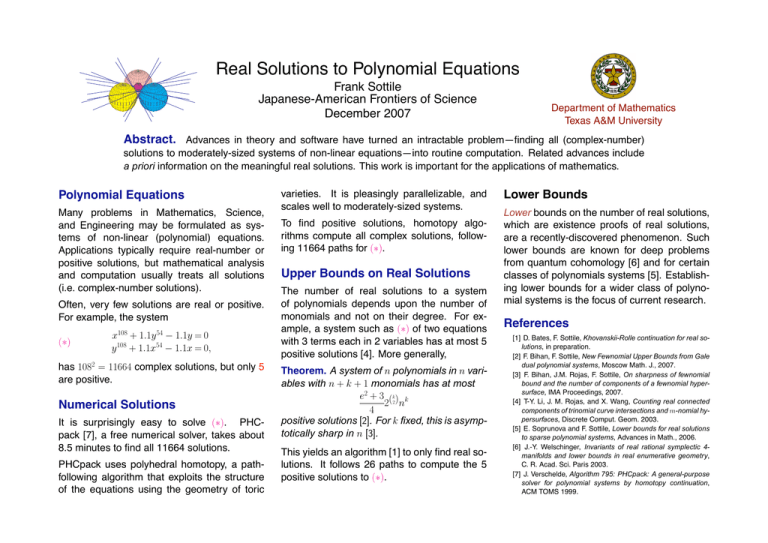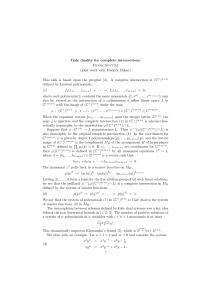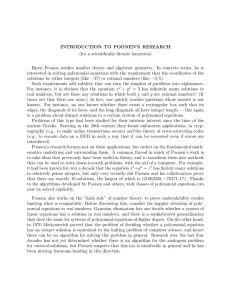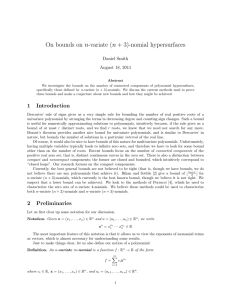Real Solutions to Polynomial Equations Frank Sottile Japanese-American Frontiers of Science December 2007
advertisement

Real Solutions to Polynomial Equations Frank Sottile Japanese-American Frontiers of Science December 2007 Department of Mathematics Texas A&M University Abstract. Advances in theory and software have turned an intractable problem—finding all (complex-number) solutions to moderately-sized systems of non-linear equations—into routine computation. Related advances include a priori information on the meaningful real solutions. This work is important for the applications of mathematics. Polynomial Equations Many problems in Mathematics, Science, and Engineering may be formulated as systems of non-linear (polynomial) equations. Applications typically require real-number or positive solutions, but mathematical analysis and computation usually treats all solutions (i.e. complex-number solutions). Often, very few solutions are real or positive. For example, the system (∗) x108 + 1.1y 54 − 1.1y = 0 y 108 + 1.1x54 − 1.1x = 0, has 1082 = 11664 complex solutions, but only 5 are positive. Numerical Solutions It is surprisingly easy to solve (∗). PHCpack [7], a free numerical solver, takes about 8.5 minutes to find all 11664 solutions. PHCpack uses polyhedral homotopy, a pathfollowing algorithm that exploits the structure of the equations using the geometry of toric varieties. It is pleasingly parallelizable, and scales well to moderately-sized systems. To find positive solutions, homotopy algorithms compute all complex solutions, following 11664 paths for (∗). Upper Bounds on Real Solutions The number of real solutions to a system of polynomials depends upon the number of monomials and not on their degree. For example, a system such as (∗) of two equations with 3 terms each in 2 variables has at most 5 positive solutions [4]. More generally, Theorem. A system of n polynomials in n variables with n + k + 1 monomials has at most e2 + 3 (k2) k 2 n 4 positive solutions [2]. For k fixed, this is asymptotically sharp in n [3]. This yields an algorithm [1] to only find real solutions. It follows 26 paths to compute the 5 positive solutions to (∗). Lower Bounds Lower bounds on the number of real solutions, which are existence proofs of real solutions, are a recently-discovered phenomenon. Such lower bounds are known for deep problems from quantum cohomology [6] and for certain classes of polynomials systems [5]. Establishing lower bounds for a wider class of polynomial systems is the focus of current research. References [1] D. Bates, F. Sottile, Khovanskii-Rolle continuation for real solutions, in preparation. [2] F. Bihan, F. Sottile, New Fewnomial Upper Bounds from Gale dual polynomial systems, Moscow Math. J., 2007. [3] F. Bihan, J.M. Rojas, F. Sottile, On sharpness of fewnomial bound and the number of components of a fewnomial hypersurface, IMA Proceedings, 2007. [4] T-Y. Li, J. M. Rojas, and X. Wang, Counting real connected components of trinomial curve intersections and m-nomial hypersurfaces, Discrete Comput. Geom. 2003. [5] E. Soprunova and F. Sottile, Lower bounds for real solutions to sparse polynomial systems, Advances in Math., 2006. [6] J.-Y. Welschinger, Invariants of real rational symplectic 4manifolds and lower bounds in real enumerative geometry, C. R. Acad. Sci. Paris 2003. [7] J. Verschelde, Algorithm 795: PHCpack: A general-purpose solver for polynomial systems by homotopy continuation, ACM TOMS 1999.







